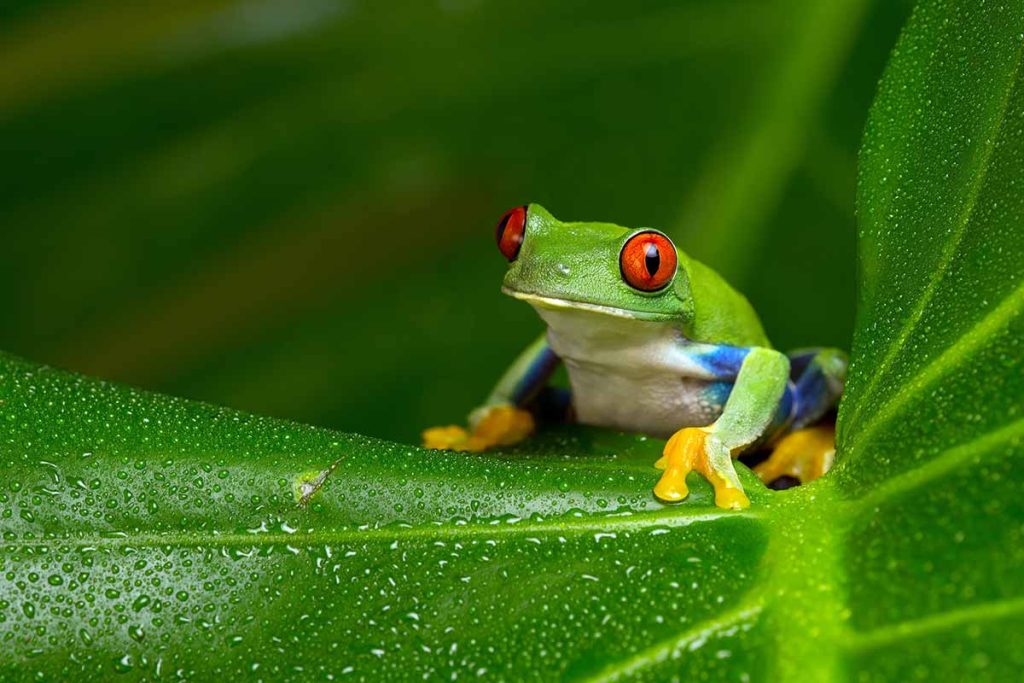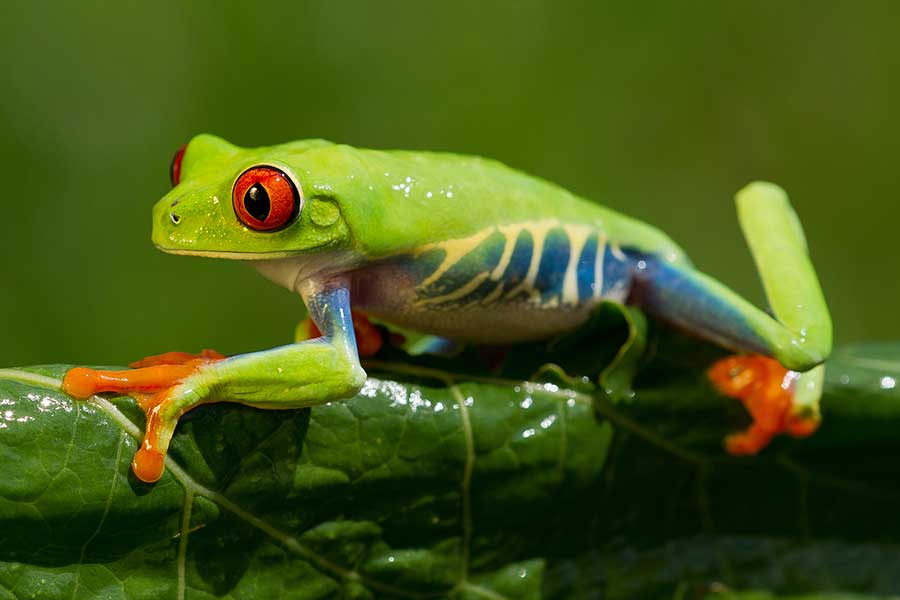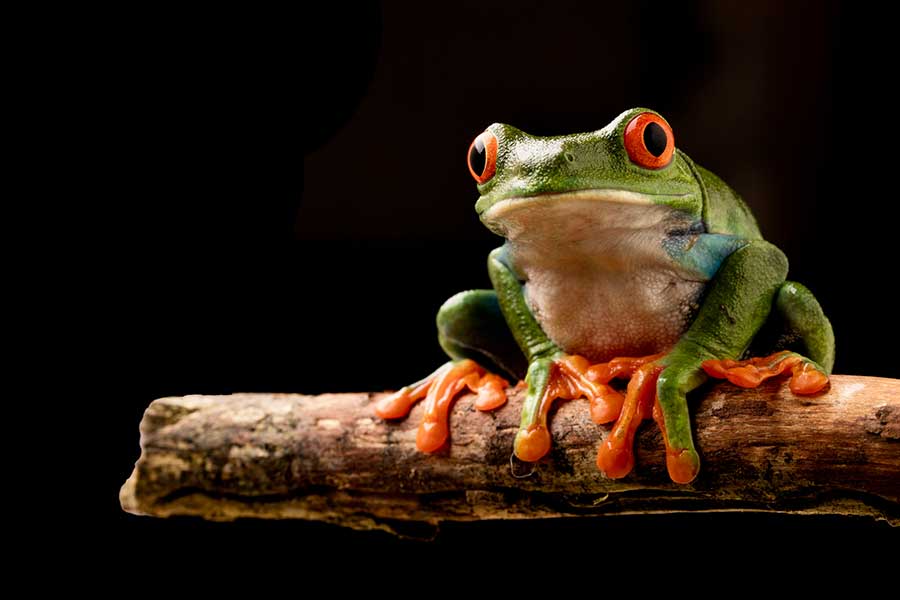Red-eyed tree frog care is very manageable, even for beginners. These stunning little hoppers require an enclosure setup that mimics a rainforest, so not only will it be like home for them but it will be a captivating display piece for you!
The key to keeping a happy and healthy red-eyed tree frog is to set up their enclosure ahead of time and get everything just right, and then be consistent in the attention that you give them and their needs. Commitment and consistency will ensure a long-lived best hopping friend!
Red-eyed tree frogs come from tropical regions and will therefore need enclosures that mimic their natural habitat.
This means they will need a fairly warm enclosure that has high humidity. If you live in a very cold region, a red-eyed tree frog may not be the best option as you will have to be extra careful in maintaining these settings when they are affected by ambient conditions.
Read on to find out how to set up and care for your red-eyed tree frog.
Red-Eyed Tree Frogs: Natural History
Red-eyed tree frogs (Agalychnis callidryas) are native to Mexico, and can be found throughout most of the tropical rainforests in South America all the way down to the western coast of Colombia.
These frogs reach an average of two to three inches in length, making them medium-sized frogs. Medium-sized frogs will require a decently sized enclosure so keep that in mind when choosing what frog you want as a pet.
For more amphibians that are beginner- to intermediate-friendly, check out our article about the top 6 amphibians for newbies and slightly experienced owners!
Red-eyed tree frogs are one of the most well-loved types of frog to own as pets because of their stunning coloration. They are bright green all over except for a few key places on their bodies. Along their sides and the insides of their hind legs, they are a dazzling royal blue.
This brilliant blue is streaked with bright yellow vertical stripes. The yellow coloration often extends up the sides of the frog’s head. Contrasting with the green and the blue, the bottoms of their feet and their large round toes are bright orange!
The most astounding physical feature is their namesake: their beautiful red or crimson eyes with their vertically slitted black pupils.
The Red-Eyed Tree Frog’s Behavior and Temperament
The physical coloration of your red-eyed tree frog is not just to look pretty for humans–this bright, aggressive coloring functions in the wild to scare and warn off predators.
Bright and bold coloring (aposematism) is often associated with toxicity or poison (think poison dart frogs) in the animal kingdom. Predators are aware that things that have this coloring will make them sick and they should not eat them.
Red-eyed tree frogs are not harmful or poisonous, though, so they have no reason to use these colors except to trick predators! This is an example of Batesian mimicry of aposematic coloration, copying (Batesian mimicry) of warning colors (aposematism).
Further, red-eyed tree frogs are nocturnal animals. This means they are active at night when they go hunting. During the day, they curl up on a branch somewhere quiet to nap the daylight hours away.
But napping on a branch with your bright colors on display is not a great way to survive predators that do not care about toxic frogs! The red-eyed tree frog takes its survival very seriously, so during their daytime siesta, they pull their hind legs up to cover their bright blue and yellow sides, close their eyes to hide the red, and tuck their toes under their bodies!
The Right Enclosure for Red-Eyed Tree Frogs
Red-eyed tree frogs are arboreal, which means they spend their lives in trees and on tall plants in rainforests once they have grown out of their tadpole stage. This means their enclosure should resemble their natural environment.
Enclosure Size
You will need to find an enclosure that is taller than it is long to meet the arboreal needs of your red-eyed tree frog. For a single frog you will need an enclosure that is 15 to 20 gallons in size.
Even though your red-eyed tree frog is small, they need a fair amount of space to move around and enough space to jump from one perch to another. You will see that they have very long hind limbs that they do need to stretch out and exercise.
Enclosure Type
Frogs need glass or plexiglass enclosures with solid sides. This is because they require high humidity levels, which in turn means they cannot have constant ventilation that screen or mesh sides would provide.
Red-eyed tree frogs also need smooth-walled enclosures because they tend to stick onto the sides and hang out for a while. If the sides are not smooth, they can fall off and injure themselves.
Wooden enclosures will swell and develop mold owing to the high humidity levels. This makes them unsuitable for red-eyed tree frogs.
The enclosure will also need a mesh or solid top or hood that clips on or is locked on to prevent escapees.
Substrate
Substrate is the ‘stuff’ that you place at the bottom of the enclosure.
In the case of arboreal species like the red-eyed tree frog, the substrate is not chosen for its comfort or what it would be like to bed down in it. Rather, the substrate is chosen for its ability to retain moisture and heat.
A good substrate will help maintain humidity levels and prevent the enclosure from getting cold too quickly at night.
The best substrates for a red-eyed tree frog’s enclosure would be coconut coir, orchid bark, coconut chips, forest floor bedding, or a combination of these.
If you find the humidity levels are not staying constant enough and are dropping significantly throughout the day, you can add some sphagnum moss to the substrate to help maintain the hydration and humidity.
As red-eyed tree frogs require such high humidity, it may be advisable to use a drainage layer at the bottom of the enclosure to prevent water from getting stagnant.
Decorations
How you decorate your enclosure is very important. Being arboreal, your red-eyed tree frog needs plenty of perches in their home.
You must have at least one horizontal perch in the enclosure where your frog can relax completely. This perch should have good access to the light as well as be partly hidden by some foliage.
Other perches can be angled all the way to vertical to provide your red-eyed tree frog with a variety of climbing options.
Perches can be made of PVC piping or of fake material designed for enclosures. However, you can also use the branches you find in your backyard!
If you choose to use natural wood, you must first sterilize it. Boil the piece of wood in clean water for 10 minutes. Then place it on a tray in the oven and bake it with the door open until it is completely dry.
Living plants are a great addition to the enclosure because it feels far more natural to your frog and helps maintain humidity.
Heating
Your enclosure must be fitted with a thermometer. A combined digital thermometer/hygrometer is ideal.
As they are native to tropical regions, red-eyed tree frogs need it quite warm but not hot.
They should have an ambient temperature of 75°F. This can be achieved by a heat bulb at the top of the enclosure. Nearest the heat bulb, the temperature should not rise above 80°F. The temperature should not drop below 68°F at night.
If you would rather use a ceramic heat emitter or under-tank heat mat, you will need to provide an additional source of light.
Lighting
Red-eyed tree frogs need some UVB light. This can be achieved by installing a small UVB bulb in the enclosure.
This will also function as the light provided during the photocycle. Your red-eyed tree frog will need 12 to 14 hours of light and 12 to 10 hours of dark every day.
They are nocturnal animals so they cannot function properly if there is light during their nighttime hours.
Humidity
Red-eyed tree frogs need a humidity range of 70 to 80 percent. This is pretty high. You can mist the enclosure twice a day to maintain these levels. However, this can become laborious and unrealistic for many people if they need to go away for the weekend, etc.
The alternative (especially if you have a larger enclosure) is to install an automatic misting system.
Always remember to use purified, dechlorinated water to mist the enclosure.
The Red-Eyed Tree Frog’s Diet
Food
Red-eyed tree frogs are carnivores! This means they only eat animal protein in the form of insects. Appropriate insects include:
- Crickets
- Dubia roaches
- Grasshoppers
- Mealworms
- Nightcrawlers
If you wish to treat them, you can give them a wax worm or butter worm to chomp on. However, treat items should be restricted to once every two weeks to avoid obesity.
You should feed your baby red-eyed tree frog two to three times a day. Once they reach adulthood, you can feed them once a day to once every two days.
Dust your frog’s food in
Food items should be no larger than the space between their crimson eyes. If the food item is too large, it could lead to choking or impaction of the gut.
Water
Your red-eyed tree frog will need a dish of water in their enclosure that is refreshed daily. Make sure you use filtered, dechlorinated water and not straight tap water.
Common Health Issues of Red-Eyed Tree Frogs
Red-eyed tree frogs can suffer from skin issues because they need their humidity so high. High humidity can be difficult to achieve and maintain for some owners. Unfortunately, when a frog’s skin dries out, cracks and breaks form.
These cracks in the skin allow bacteria to find purchase and the skin then becomes infected. It is essential that the humidity levels are maintained in the enclosure at all times.
FAQs About Caring for Red-Eyed Tree Frogs
Can I keep more than one red-eyed tree frog in one enclosure?
The good news about red-eyed tree frogs is that they are not too territorial! This means that you can keep multiples in one enclosure. However, there are some things that you need to be aware of.
- The frogs in the enclosure need to be of the same size. If they are different sizes then the larger ones may try to eat the smaller ones!
- You will need to increase the size of the enclosure for every frog that you add. Two or three red-eyed tree frogs can happily live in a 30- to 40-gallon enclosure. You can add many frogs to the same space if you continue to size up the enclosure and meet their needs.
- You must meet all of their needs equally. No matter how many frogs you have in the enclosure, they each need their own perch. They each need to be monitored for their health and wellbeing, and they all need to be fed equally.
The danger of housing too many frogs in the same enclosure is that they will start to feel too stressed and crowded. You will also run the very high risk of your frogs spawning, and if you are not ready to be a froggy grandparent, this could be an unwelcome surprise.
How often can I handle my red-eyed tree frog?
Red-eyed tree frogs are amphibians. This means they have skin that is permeable. Permeable skin allows things that are outside of the frog’s body to pass into their body through their skin and vice versa. This process helps them to breathe!
However, this also means that any toxin that touches their skin will make its way into the body and cause damage. Frogs are very sensitive to chemicals that you find in your everyday life that you may not consider to be toxic, like mild, unscented dish soap!
Red-eyed tree frogs are also very delicate and have bones that can break easily if mishandled. They are also prone to jumping when spooked so they often jump from a handler and land on the floor, resulting in injury.
It is best not to handle your red-eyed tree frog unless it is absolutely necessary in order to clean their enclosure.
If you do need to handle them, follow these steps:
- Wash your hands with mild dishwashing soap in hot water for at least 20 seconds
- Rinse your hands of all soap for a further 10 seconds with dechlorinated water
However, just because you shouldn’t handle them does not make them a bad pet. They are stunning display animals.
Are red-eyed tree frogs good pets for children?
Red-eyed tree frogs, and all amphibians honestly, do not make good pets for children.
Amphibians are very hands-off creatures, so there is not a lot of reward in caring for them for children who prefer to give cuddles and scratches. Red-eyed tree frogs live for 10 years on average, which means they are a serious time commitment.
Amphibians also require consistent attention and care from owners, which can become tedious for children and even teenagers. This means the responsibility will fall to the adult, or the frog will end up suffering and dying.
However, if you are looking for an animal for your child that is a little spicier than a dog or cat, check out our list of reptiles that are perfect for children!
Hopping Off on Red-Eyed Tree Frogs
Red-eyed tree frog care is a little complex to set up and get running; however, once you have everything operating smoothly, the rest is a breeze.
These little hoppers will bring you endless hours of joy and fascination. They are mesmerizing to watch as they move around and blink their eyes, flashing little pops of color at you. At night, when they go on the hunt, they are patient creatures that surprise you with their quick strikes.
These beautiful bundles of energy will be with you for a long time so make sure you are committed to the long haul. Caring for a red-eyed tree frog is a truly rewarding experience!




